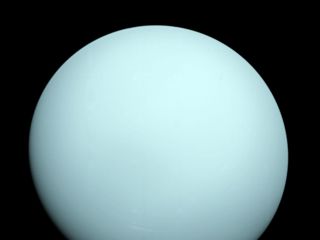
William and Caroline Herschel
- 25th Aug 2022
- Author: Ed Kellond-Turner
25 August 2022 marks 200 years since the passing of William Herschel, one of the most prominent astronomers of all time. However, he wasn’t the only famous stargazer in his family. His sister, Caroline Herschel, made plenty of discoveries of her own. Along with their individual discoveries, the siblings also scoured the night sky together over many years. This blog investigates the siblings' individual work, as well as what they managed to achieve together.
William Herschel
Frederick William Herschel was born in the Electorate of Hanover (today a part of Germany) in 1738, emigrating to Great Britain in 1757. Before his work in astronomy, William was a keen musician, composing numerous symphonies and concertos, including this piece written in 1762. This work resulted in him being appointed as the first organist of the St John the Baptist Church in Halifax in 1766, and the director of the Bath orchestra in 1780.
William began looking to the night sky in May 1773, noting his observations of Saturn’s rings and the Great Orion Nebula in an astronomical journal. William would build his own reflecting telescopes with the help of his sister Caroline and brother Alexander, the largest of which had a 40-foot focal length, which was the largest scientific instrument at the time.
The most notable of Herschel’s discoveries was Uranus in 1781, originally named “Georgian star” after King George III (luckily this name didn’t stick!). This was the first discovery of a planet since ancient times, resulting in a quick rise to fame. This discovery resulted in Herschel being appointed as Court Astronomer by King George III. Further to this, he discovered over 800 double or multi-starred systems, two moons of Saturn, two moons of Uranus, the seasonal changes of the Martian ice caps, infrared radiation, and over 2400 objects varying from nebulae to galaxies.
Due to his success, Herschel became a prolific figure in the scientific community. He was elected as a Fellow of the Royal Society, who awarded him the Copley Medal in 1781, he was made a Knight of the Royal Guelphic Order in 1816 and became the first President of the Royal Astronomical Society in 1820.
Herschel died on 25 August 1822 after a lengthy illness. His grave is inscribed rather appropriately with the Latin phrase ‘coelorum perrupit claustra’, meaning ‘he broke through the barriers of the heavens’.
Caroline Herschel
Caroline’s early life was not like William’s. She was struck with typhus aged ten, which stunted her growth and left her blind in her left eye. This led her family to assume she would never marry, so they trained her as a house servant. It wasn’t until her father’s death, when her brothers William and Alexander proposed she join them in England, that she was able to begin her studies. She became an accomplished singer, accompanying William in his concerts, before transitioning to supporting his efforts in astronomy.
Whilst she was initially relegated to simply supporting her brother, she was able to make her own observations, making her first discovery on 26 February 1783, finding a nebula not yet included in the Messier catalogue, and Messier 110, the second companion of the Andromeda Galaxy, the closest spiral galaxy to the Milky Way.
William built a comet-searching telescope for Caroline in 1783, leading to Caroline discovering eight comets between 1786 and 1797, which resulted in King George III appointing her as the first woman in England honoured with an official government position and the first woman to be paid for her work in astronomy with an annual salary of £50, or £6,800 in today’s money.
Caroline became an honorary member of the Royal Astronomical Society in 1835, one of the first woman members along with Mary Somerville, and has several astronomical objects named after her, such as NGC 7789 (Caroline’s Rose), and the C. Herschel crater on the Moon. At the age of 96 she was awarded the Gold Medal for Science by the King of Prussia.
Caroline died on 9 January 1848. Like William, the inscription on her grave is an appropriate representation of her work; ‘the eyes of her who is glorified here below turned to the starry heavens’.
Astronomy Rap - Caroline Herschel
Their Legacy
In total, the Herschel siblings discovered and catalogued around 2500 objects, ranging from nebulae to star clusters. Near the end of Caroline’s life, she grouped and listed these objects into zones of similar polar distances, a task that would enable William’s son, John, to re-examine them systematically. This catalogue became the foundation of the New General Catalogue, published in 1888 and containing 7840 deep sky objects, including galaxies, clusters, and nebula. The NGC numbering system is still the most commonly used identifying label for celestial objects, such as the one seen in the image on the right.
While both extraordinary astronomers individually, it’s clear the Herschels could not have achieved as much as they did without each other. Their legacy continues to this day, 200 years after William’s death.
Full image credits / references
(Banner image) Uranus as seen by Voyager 2. Credit: NASA
(1) A Portrait of William Herschel, From Page 6 of Hector Macpherson - Herschel (1919). Credit: Photo by Emery Walker (1851–1933), Public domain, via Wikimedia Commons
(2) Caroline Herschel Portrait, by painter Melchior Gommar Tieleman. Credit: Public Domain
(Video) Astronomy Rap - Caroline Herschel. Credit: National Space Centre https://youtu.be/SNUuF_p6_vo
(3) An Infrared Composite Image of the Two Hemispheres of Uranus Obtained With Keck Telescope Adaptive Optics. Credit: NASA




